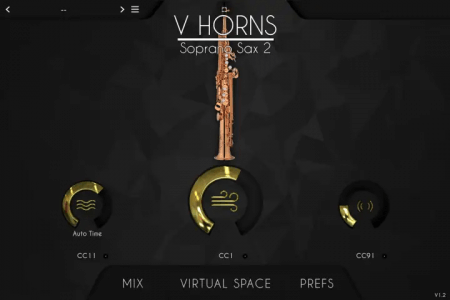Samplecraze Using Modulation To Shape a Delay Effect's Filters TUTORiAL

FANTASTiC | 25 October 2020 | 126 MB
Detailed tutorial on how to use source and destination modulators with a delay effect to create spatial soundscapes.
Using Modulation to shape a Delay Effect’s Filters is a video tutorial that explains what modulators are and how to use them to modulate various parameters on plugins.
Sound designers have been using modulators for years. The modulation matrix that houses both source and destination modulators is where all the funky programming takes place to shape the sound. Nowadays, music producers use modulators to control and shape sounds, dynamics, and effects.
Before we can get creative with modulating effects, and in this case a delay effect, we need to understand what modulators are.
What is a Modulator
A modulator is a device that controls the parameters of another device. The modulator is called the source and the device being modulated is called the destination. A good and simple example of a source modulator is the pitch wheel on a keyboard and in this instance the destination is pitch. In other words, the pitch wheel when moved alters the pitch of the sound being played.
Almost anything can be a source modulator. Most synthesizer keyboards have a dedicated modwheel (modulation wheel) which can be assigned to a whole host of destination sources and we can replicate this scenario in our DAWs. In fact, we can design our own modulators and have them trigger all manner of processes. We can use Midi controllers to control any desired destination and now we can even use audio to modulate another piece of audio. And it doesn’t end there. Most DAWs give you extensive source modulators to use in the Automation Lanes. In effect, we can use a shape to control the volume of the audio.
However, in this tutorial, we are going to use a delay effect that has its own built-in modulation matrix – FabFilter Timeless. This particular delay effect has a very detailed and comprehensive modulation matrix (mod matrix). Every parameter of the delay effect can be modulated and this gives us huge scope for some very cool sound design possibilities.
Source Modulators
In this tutorial I am using two source modulators: the first is an LFO and the second is an Envelope Generator (EG).
LFO – Low-Frequency Oscillator
Low-Frequency Oscillators LFOs are often used as source modulators as they can have varying shapes and can be both cyclic and random and they can modulate (control) a whole host of destinations. An LFO is a low-frequency oscillator and it oscillates at a far lower frequency than a traditional oscillator (usually at around 10 Hz). This means that it is not heard like a traditional oscillator but still cycles like one and is, therefore, a great source modulator to use for cyclic events.
Common examples that use an LFO as a source modular are:
Tremolo – the amplitude (volume) is modulated by an LFO.
Vibrato – the pitch is modulated by an LFO
Flanger – is another modulation effect whereby the delayed signal, which is added back to an equal amount of the dry signal, is modulated by using an LFO.
Phaser – behaves in much the same way as chorus and flanging but with shorter delay times and the effect itself is far more subtle. Because phasing works with shorter delay times than chorus and flanging the impression is that there is only one sound as opposed to two distinct sounds and because the LFO modulates frequencies (peaks and trough, also known as notches) the filtering effect is quite pleasing.
Now that we understand how an LFO can affect a sound we can start by using LFOs to modulate different destinations to the usual amplitude and pitch.
Source modulators are not constrained to using LFOs. We can use an envelope generator (EG) to modulate any destination.
Envelope – shape
An envelope denotes a shape that controls the amplitude (volume) of a sound over time, and the most common envelope parameters are ADSR (attack, decay, sustain and release). However, what we want is an envelope generator that can be used to modulate ANY destination as opposed to amplitude.
Envelope Generator (EG)
Also called Contour Generator the envelope generator generates a control signal which can be used to represent the envelope (shape) of the destination.
In the Using Modulation to shape a Delay Effect’s Filters video, I explain what LFOs are, what Envelope Generators are and how to use them to control various destination parameters like filter frequency and filter pan. I show you how to use various LFO shapes to trigger different responses from the filters and I end the tutorial by showing you how to use an envelope generator to modulate the filter frequency overtime of a drum beat.
The plugin used in this video:
FabFilter Timeless
Topics covered in this video are:
Understanding Modulation
Source and Destination
Modulation and Spatial Effects
Understanding the Matrix
Envelopes
Filters and Filtering
Positive and Negative Responses
Modes and Resonance
home page:
https://bit.ly/2Hx3cTD
DOWNLOAD
Related News:
 Ask Video Bitwig Studio 2-201 The Modulators Explored TUTORiAL
Ask Video Bitwig Studio 2-201 The Modulators Explored TUTORiALSYNTHiC4TE | April 11th 2017 | 223 MB The new Modulators in Bitwig Studio 2 make it one of the most powerful and flexible DAWs anywhere. In this exclusive 26-tutorial course, Bitwig Certified Pro Thavius Beck gives a detailed tour of these amazing new devices!...
 K-Devices Modulators v1.1 for Ableton Live v9.7.1 ALP
K-Devices Modulators v1.1 for Ableton Live v9.7.1 ALPSYNTHiC4TE | March 19 2017 | 43 MB Get deep with the multi-functional LFO, create a sequence of randomized preset states, or modulate parameters using an audio signal – this set of envelope followers and other device controllers can reinvent how you use your instruments and effects, and take your modulations to the molecular level....
 Saltline Brzoza Ver.1.0.1 WIN
Saltline Brzoza Ver.1.0.1 WINSaltline Brzoza Ver.1.0.1 WIN | 8.96 MB Brzoza is a two operator mono FM synthesizer. Each operator has three, fixed route, modulators. modulation amount is controlled by the modulator's ADSR envelopes. A wide range of sounds and textures can be created from tight, soaring leads and deep basses to "bell" like sounds and evolving textures....
 FXpansion Bloom v1.0.0.5 MacOSX WORKING-R2R
FXpansion Bloom v1.0.0.5 MacOSX WORKING-R2RFXpansion Bloom v1.0.0.5 MacOSX WORKING | 8.4 MB Team R2R 2013.03.11 FXpansion is proud to present Bloom, a creative delay effect plugin with additional diffusion network, effects, advanced modulation and much more. Bloom's varied delay modes and lush diffusion reverb instantly introduce new textures and spaces to your productions. Dig a little deeper to discover new ways of using delay for...




Comments for Samplecraze Using Modulation To Shape a Delay Effect's Filters TUTORiAL:
No comments yet, add a comment!